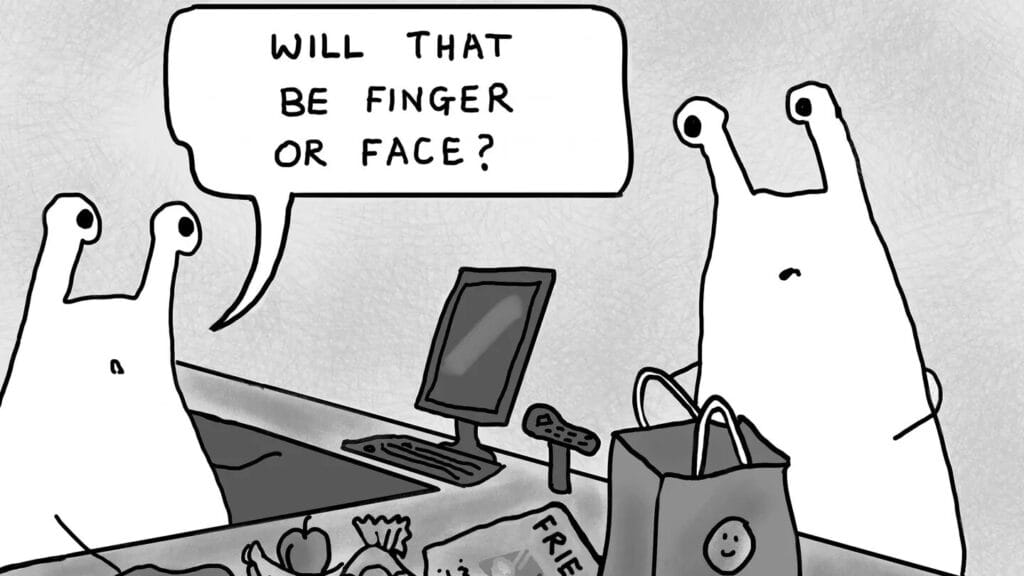The following report is by David G.W. Birch for Forbes:
JPMorgan Chase is planning a broad rollout of biometric payments with U.S. retailers by early next year, enabling shoppers to make purchases by scanning their palms or faces. The bank’s executive director of biometrics and identity solutions, Prashant Sharma, said, “We would like every merchant to adopt this, but at the end of the day, it is going to be a merchant’s choice.” He is right, of course, but it is interesting to reflect on why merchants will choose to go down this route.
SEE: JP Morgan To Launch Their Contactless And Facial Recognition Payment System In 2025
Convenience In Stores
When it comes to retail payments, the fact is that convenience always comes first. So while merchants and financial institutions have to have security as table stakes, consumers have to have convenience. Biometrics, when implemented correctly of course, can deliver both. At retail point-of-sale, such systems are a win-win.
This is why I share that bullish take on the technology even in the U.S., which has in some cases been slow to adopt new payments technology. It adopted chip and PIN and then later contactless after all its peer countries and could do the same with biometric payment technology. Just one in four Americans are comfortable using a biometric hand scanner for payment. Meanwhile, 50% of Canadian and British consumers are open to adopting biometric payments and log-ins.
In fact in the U.S., while consumer confidence in facial recognition biometrics for security purposes remains high, support for the use of the technology in retail settings has fallen significantly over the last couple of years. I think, as other observers do, that these consumer attitudes are a function of familiarity, which is why they will change quickly. The more exposed consumers are to biometrics at POS, the more comfortable they will be with this technology.
Americans are already beginning to experience a variety of new biometric payment options and I am sure that much wider adoption will accelerate. One place that Americans will become more familiar with the technology is sports and events where the technology is already being used to great effect. Amazon, for example, launched the Just Walk Out store in the Seahawks’ Lumen Field NFL stadium some time ago. The AI-based checkout allows fans to enter a concession stand, grab what they want, and walk directly back to their seats without going through a checkout process. Fans clearly like it, because the stadium saw double sales when compared to the previous store in the same location.
SEE: NFL To Rollout Facial Recognition Centralized Credential System All Stadiums For 2024 Season
(Amazon is moving away from Just Walk Out for its retail stores and is focusing on its Amazon One palm recognition solution, having just launched an app which lets customers sign up for the service using their phone instead of visiting a store. Customers can create their profile by logging into their Amazon account, taking a photo of their palms and adding a payment method. There are now 500 Whole Foods Market stores in the U.S. using Amazon One, along with several Amazon stores and more than 150 third-party locations including stadiums, airports and convenience stores.) SEE: Amazon Announces Their Contactless Palm-Reading Payment Method Will Be Available At All Whole Foods
Many sports franchises and event locations are moving to cashless checkout experiences using biometric technologies. Fans of the Colorado Rockies, the Boston Red Sox, the Kansas City Royals, the Houston Astros and many others are moving to similar palm, face and other solutions. Such cashierless biometric checkouts process transactions faster than traditional checkouts, which is particularly important in sports and event setting where there are big peaks in customer demand. SEE: MLB Team Houston Astros To Use Facial Recognition To Quicken Fans’ Entry, Tokenizes Authenticate Fans’ Likeness

I think many merchants will indeed choose to go this way because there is a particularly appealing aspect to this type of fast and convenient authentication at the check out, in that it enables a retailer to combine both an authenticated payment transaction and an authenticated loyalty transaction in one “identity ceremony” so that the customer can complete both transactions without needing to present cards, a phone or anything else. Now, the idea of linking a biometric identifier to a payment mechanism to speed up checkout in the grocery store is hardly new or revolutionary (after all, Piggly Wiggly did this 20 years ago) but as the technology becomes more accurate and therefore more convenient, it will inevitably scale to meet both consumer and merchant demands.
Worth The Risk
Now there is a risk, of course, and that is that consumers will shy away from biometrics because they are concerned about surveillance and the potential for misuse. These are entirely reasonable fears, by the way. Prashant notes that while their may be some sensitivity around biometrics, the banks “don’t see this as a big risk.” I think he is right, provided that the industry is up front with consumers about how biometrics work. It seems to me that the way to deal with consumer concerns is to be entirely transparent about how the relevant templates and other data is collected, stored and used. This openness is crucial to scale use of the technology.
Given that Goode Intelligence forecasts the global biometric payment volume at almost $6 trillion (with 3 billion users) by 2026, I think we can say that JPMorgan Chase’s decision to get behind the technology for payments is going with the grain. Speaking as a shopper, who has used the same supermarket, with the same loyalty card and the same payment card and pretty much the same coupons for decades, I can’t wait for this technology to come to my local store.
AUTHOR COMMENTARY
“I can’t wait for this technology to come to my local store.” -Oh, I’m sure you can’t. People are steadily becoming more and more giddy to accept this new wave of digital tyranny, so blind, deceived and comatose they cannot see the trap that has been set for them; all in the name of so-called “convenience” and “security.”
Though we are not quite there yet, we are watching more bricks being laid for the mark of the beast infrastructure and system.
[16] And he causeth all, both small and great, rich and poor, free and bond, to receive a mark in their right hand, or in their foreheads: [17] And that no man might buy or sell, save he that had the mark, or the name of the beast, or the number of his name. [18] Here is wisdom. Let him that hath understanding count the number of the beast: for it is the number of a man; and his number is Six hundred threescore and six.
Revelation 13:16-18[7] Who goeth a warfare any time at his own charges? who planteth a vineyard, and eateth not of the fruit thereof? or who feedeth a flock, and eateth not of the milk of the flock? [8] Say I these things as a man? or saith not the law the same also? [9] For it is written in the law of Moses, Thou shalt not muzzle the mouth of the ox that treadeth out the corn. Doth God take care for oxen? [10] Or saith he it altogether for our sakes? For our sakes, no doubt, this is written: that he that ploweth should plow in hope; and that he that thresheth in hope should be partaker of his hope. (1 Corinthians 9:7-10).
The WinePress needs your support! If God has laid it on your heart to want to contribute, please prayerfully consider donating to this ministry. If you cannot gift a monetary donation, then please donate your fervent prayers to keep this ministry going! Thank you and may God bless you.








Mouse trap.
And their placing the cheeses for it.